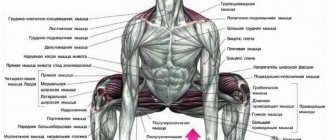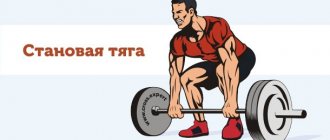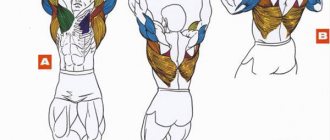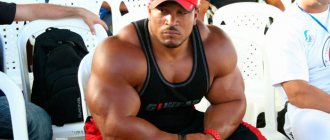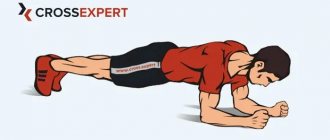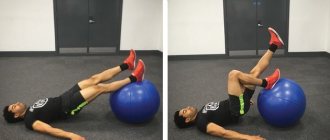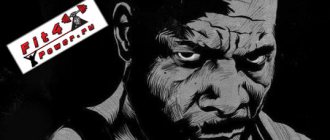Based on the method of training squats and bench presses, you have obviously already developed your firm understanding of the principles of strength training. And you are ready to hear what I tell you about traction:
“Train it twice a week, alternating between hard and easy days, starting your training cycle with sets of 10 reps, then moving on to sets of 6, 4 and then, as the competition gets closer, 2 and 1.” Recommendations like these are the basis for training bench presses and squats, but forget about them when it comes to deadlifts. If you try to train the deadlift the same way as the other two movements, you will fail, perhaps catastrophically.
So what makes traction different?
Unlike squats and bench presses, deadlifts work the main muscle groups under difficult biomechanical conditions. The quadriceps, the main producers of force in squats, are involved in deadlifting only at the very beginning of the lift. The pectoral muscles, deltoids and triceps, although they come to a state of maximum tension, nevertheless do not make a significant contribution to the final result. The basis of the power in the deadlift lies in the back. The rectus dorsi muscles, located in the lower and middle parts, are the main muscles that straighten the torso, but they are forced to carry out their work in extremely unfavorable conditions. The muscles of the upper back, as well as the trapezius, are actively involved in the work. By the way, it is precisely by the developed trapezius muscles that you can always easily recognize a real lifter. Rarely does a bodybuilder seriously work on this muscle area. However, it is these muscles that give the athlete’s figure that comprehensive impression of strength and power that distinguishes the Great from their “fellow travelers.”
So, deadlift is the result of a “team” effort. When you attempt a maximum weight lift, I'm willing to bet that it's impossible to find a single muscle in your body that isn't at maximum tension, from your toes to the top of your head. The deadlift is the result of a total effort, and no one muscle group can lift more than its share of the load. But the entire movement requires the overall strength of your body. And this strength is not something that can be reflected in the protocol of bodybuilding competitions or a centimeter tape. This power manifests itself, for example, when your life is in danger.
The paradox of deadlift training is that although your muscles are theoretically capable of supporting weights in excess of 400 kg (as proven by outstanding lifters), you cannot withstand the training loads that should bring your body to that maximum attempt. The fact is that the small muscle groups directly involved in performing deadlifts represent the weakest link in the overall system and your entire training is limited by the capabilities of these particular muscle groups. Heavy back training often causes stress and even injury to the most vulnerable parts of your body, such as the lumbar spine. The slightest inconsistency during lifting can damage the spinal nerves, which leads to severe injuries, although the athlete’s muscles form a kind of frame that supports the organs.
The Relationship Between Reps and Weight
Knowing how many reps to do will also help you know how much weight you should use. These two concepts are inextricably linked. If you were to plot a graph, you would find an almost linear inverse relationship between the two: by adding more weight, you can do fewer reps; With less weight you can do more repetitions.
It can sometimes be surprising when an athlete gets stuck on a certain weight and rep pattern—say, 25kg dumbbell bench press for 8 reps. You tell him to take 28 kg, to which he replies: “I can’t do that!” Well, yes, he can - just not for 8 reps, but for 6. Inevitably, he will cope with 28 kg, and with this new feeling of strength he will even try 30 kg and 35 kg.
This is an important point: you don't have to train in the same rep range all the time. You can start your workout with a heavy compound exercise for 5 sets of 5 reps. To focus on building muscle, you can follow this up with a few exercises in the 8-12 rep range. To complete your workout, you can even tap into your slow-twitch muscle reserves and finish with an isolation exercise in the 15-20 range.
Over time, you will understand your personal strength curve and weight-to-rep ratio for each exercise. By recording your performance in a diary, you can keep track of the number of repetitions and weights used. This is important because as you get stronger, you will want to lift more weight in the same rep range. When building muscle, once you can do more than 12 reps on a main exercise, it's time to increase the resistance by about 5 to 10 percent.
The weight you choose on the strength curve should match the number of repetitions you want to achieve, which is consistent with your training goals. In this sense, training should never be a haphazard exercise where you just pick up any old weight; there is an optimal weight and an optimal number of repetitions you should do. It all depends on which goal is preferred!
How to train deadlift?
It must be trained with fairly heavy, but not excessive, weights. You can't train deadlifts too often and you can't do a large number of repetitions in one approach. Each workout should begin with small weights and increase the weight of the barbell from approach to approach.
Deadlift, like no other movement, requires a special emotional state. Lack of fear of heavy weights can give good practical results. Since the back muscles work in pulling under complex biomechanical conditions, special attention should be paid to correct technique. The bar of the barbell throughout the lift should be as close as possible to the athlete’s body, the back should be arched, or at least straight, but never concave, and be sure to include the legs in the work so that the weight is optimally distributed between the muscle “team”.
Varieties of grip
In the deadlift, grip is of no small importance, especially for professional athletes. For example, in powerlifting competitions they most often use a different grip (one palm outward, the other inward), which allows you to lift more weight. This grip is not recommended for beginners; a different grip in this case can cause spinal problems for the athlete. In the classic version of the deadlift, the grip is always straight (upper), it is also used taking into account jerks. Experienced athletes sometimes prefer a reverse grip, which allows them to develop maximum force. The width of the grip depends on the position of the legs, since the hands should not interfere with the exercise.
How often should you train deadlifts?
Contrary to popular belief, deadlift training even once a week is a lot! Deadlifts should be trained once every 10 days or even once every two weeks. It's not easy to resist not training such an important movement as the deadlift more often. However, it is better not to draw bitter lessons from this kind of experience.
One way to rationally use the seemingly unreasonable pause in deadlift training is to consider squats as an auxiliary exercise for deadlifting. This often helps the training process, and undoubtedly makes a significant contribution to the successful completion of the first phase of the deadlift.
If you train the deadlift too often, you'll soon see that your squats begin to suffer, since your lower back is worked hard in both exercises and it needs to have plenty of time to recover.
Common Mistakes
The deadlift is a high-impact exercise and must be performed with proper form to minimize the likelihood of injury. Also, a well-executed technique is the key to effectively working the target muscles.
Incorrect foot placement
When doing a classic deadlift, it is better to place your feet so that the distance between the soles is equal to the width of one foot.
Incorrect hand placement
When performing a classic deadlift, your hands should be positioned slightly wider than your hips, not too narrow and not too wide. If your hands are placed closer to each other, they will touch your knees.
How many repetitions to perform in one approach?
The number of repetitions in deadlift training should be minimal. Apparently, 4 repetitions per set is enough not only in training, but also in warm-up!
Significantly increase the weight between sets to quickly reach the barbell weight needed for the main work. Try to avoid two or more repetitions when approaching maximum and submaximal weights, because this requires a significant expenditure of mental energy, which you will need for competitive approaches. A typical workout for a lifter hoping to lift 270 kg in competition might look like this:
- 100 x 4
- 140 x 4
- 180 x 4
- 210 x 4
- 230 /2 x 4
Technique by type
Let's start analyzing the execution technique with the classics with a barbell:
Classic with barbell
The technique, of course, will be the same for men and women, but it is this classic option that is traditionally chosen by boys, because They care more about the overall development of muscles and strength, rather than targeting specific muscles.
How to do deadlifts with a barbell:
- Come close to the bar, place your feet narrower than your shoulders and parallel to each other (or place your feet wider than your shoulders - you will get a sumo deadlift with more load on the glutes).
- Squat down and grab the barbell with an overhand grip, the distance is slightly wider than shoulder width. The arms are vertical, the shoulders are under the barbell, the gaze is directed straight ahead.
- Take a deep breath and, as you exhale, begin to lift the barbell. The takeoff is smooth and even (no jerking from the floor), the bar slides along the legs, make sure that the bar moves along a vertical path and passes as close to the shins and hips as possible.
- Keep your back (as in a squat) strictly straight, with a natural arch in the lower back.
- After passing the barbell through your knees, you should straighten up completely, slightly squeeze your shoulder blades together, and proudly push your chest forward. Important point : the barbell does not need to be pulled with your hands; they act as cables.
- We return to the starting position. Lowering the barbell begins with bending your knees, moving your buttocks back and simultaneously lowering your straight back forward. It is very important to ensure that the back does not round , to keep it straight using the abdominal muscles and erector spinae, as well as the flattened shoulder blades.
Beginners need to strengthen their back and leg muscles before starting deadlifts. Do hyperextensions , pull-ups , squats and lunges .
On straight legs
What is the difference between classic deadlift and Romanian deadlift, what are the differences with the so-called. dead? Yes, everything: the stereotype of movement, the effect, even which muscles ultimately swing.
As for the deadlift on straight legs, which, according to the movement stereotype, is a complete analogue of the “good morning” bend over with a barbell on the shoulders or the Romanian deadlift, this version of the deadlift will not be a general strength exercise like the classic or sumo.
The technique of performing Romanian deadlifts on straight legs with a barbell and dumbbells is described in detail in this article .
This is a highly specialized exercise for the back extensors and hamstrings, and secondarily for the glutes. When performing deadlifts on straight legs, the impact on the spinal extensor muscles becomes dangerous, so deadlifts on straight legs should be performed extremely carefully and only under the supervision of a trainer .
And remember that “straight legs” is a relative definition, the knees should ALWAYS be slightly bent, and the barbell weights should be light.
With dumbbells
How to perform this variation correctly? There are no fundamental and important differences in the technique of performing deadlifts with dumbbells - the stereotype of movement is still the same, attention needs to be paid to the same points, so there is no point in retelling it.
We are often asked, what is better, a barbell or a dumbbell? What would be more effective to perform deadlifts with in this case? Well, that's an interesting question. Let's think about it:
- The most obvious difference: limited weight . The barbell is more variable in terms of increasing working weight.
- Asymmetrical load . Most barbell movements are performed symmetrically in the lateral plane. These include deadlifts, squats, and bench presses - in them both arms/legs must perform the same actions. The barbell forces the body to “tighten” its weak points so that there are no various distortions and displacements during movements.
- On the other hand, dumbbells may provide better balance , especially if you have problems with coordination or strength development in your arms/legs. Lifting two loads simultaneously and synchronously will help distribute the load more safely.
- In addition, dumbbells give him more wide range of motion, this is especially important for those whose technique cannot be canonical due to some characteristics - too long arms / short torso / unstretched muscles, etc.
The barbell in such a situation will be much more uncomfortable and traumatic. Dumbbells can comfortably place the weight around your body and work in a more anatomically convenient range of motion for you.
- Movements with dumbbells are more natural for the body from a biomechanical point of view, so the dumbbell version should be the starting option for beginners - technically it is easier, since the dumbbells can be placed on the sides of the body, thus bringing their center of gravity closer to the center of gravity of your body.
In general, of course, the classic deadlift is a deadlift with a barbell. Dumbbells cannot provide the required working weight, plus most people, instead of deadlifting with dumbbells, end up with something between a Romanian and squats.
Holding dumbbells the same way as a barbell so that the load is applied to the same muscles is difficult and uncomfortable, therefore, when performing deadlifts with dumbbells, you do not need to use a huge working weight, it is better to work in a high repetition range (12 and above), concentrate on stretching and contraction of the working muscles and adhere to the filigree technique of performing the exercise.
For this reason, deadlifts with dumbbells are perfect for girls and less so for men (although someone knows that) - it is effective, and the risk of injury when performing it is minimal.
And more classically, strength training enthusiasts do this: deadlifts are done with a barbell/bar, and Romanian (deadlifts) are done with dumbbells for better isolation.
On one leg
Read all about this type of deadlift The secret and very effective exercise for the buttocks: Romanian single leg deadlift
With a weight
Let's say together - you don't need it. We don’t like this type of deadlift - the center of gravity shifts and you get a certain echo of a squat, this is not a canonical, correct execution. In this position, more stress will be placed on the legs rather than on the back.
You can, if you choose, do kettlebell deadlifts with a wide stance, two kettlebells at once, or a kettlebell in one hand. But of course, the option with a barbell loads the muscles much more effectively.
For girls
If you are looking for an option that will load the buttocks and the back of the thigh more strongly and better, then a) always lower the barbell/dumbbells to the floor and get up from the squat, don’t try, b) add the Romanian deadlift to your training, c) try the deadlift from the pit.
Out of the pit
Important: this is the most difficult type of deadlift, both in technique and execution, and it is very easy to get injured. Suitable only for experienced ones, with good stretching, without problems with knees, hip joints or back.
The pit row is generally performed in the same way as the classic version, but the person stands on a stand/elevation of 5-10 cm, this can be (and most often) a CrossFit disc. Thus, the barbell must be pulled and lowered to a lower position. The amplitude increases - the efficiency increases.
You must lower your pelvis low, so that your knees are completely bent - this is unrealistically difficult, we’ll say it right away and blab it out again - it’s dangerous, so it’s better not to joke with this exercise.
The technique in the pit deadlift is fundamentally the same as in the classic exercise. However, if you do not have the proper stretch, you will have a very difficult time lowering and lifting the barbell, especially with weight, since you still have to reach it. Also, you can’t get too high, otherwise you will definitely stretch, and God forbid, injure the muscles to the point of rupture.
With elastic band
There are several options for using an elastic band (tape expander). You can either perform deadlifts only with it, or use it as additional equipment to the existing weight in the form of a barbell or dumbbell:
There is another interesting way to use bands (in the video) - this is an excellent option for those who need to work on the final phase of the movement, when the weight is maximum and the barbell is at the top, and also practice breaking the barbell off the platform.
What are the advantages of working with rubber bands:
- Single band deadlifts allow you to place the weight on the sides of your body, which is more comfortable for people with joint and back problems.
- The more you bend your legs, the more your glutes will work. The less, the more actively the back surface of the thigh will be involved in the work.
- In order to better feel the buttocks, it is better to combine it with leg raises in the simulator or gluteal swings .
What does science say? The most informative is a meta-analysis of resistance band training research by Chris Beardsley, a scientist and managing director of Strength and Conditioning Research. After analyzing a huge amount of data, the scientist came to the following conclusions:
- Elastic resistance can result in comparable or even greater levels of muscle activity during an exercise compared to similar free weight exercises with the same relative or absolute loads.
- If the goal is maximum hypertrophy, you should use both expanders and free weights in your exercises, because these exercises are different in nature and involve muscles in different ways.
- Exercises with resistance bands involve less joint force than similar exercises with free weights - this reduces the risk of injury.
- It makes sense to perform exercises not for the number of repetitions, but for a time - start with 30 seconds.
- Combine exercises with free weights and resistance bands rather than focusing on just one thing.
In Smith
In general, there are no differences in technology from the classics. In fact, performing a deadlift in Smith is an easier and much less traumatic and gentle option compared to free weights. But, at the same time, it must be admitted that it is less effective for developing strength and mass compared to a barbell.
Pros and cons of Smith machine deadlifts:
- The Smith machine sets the correct trajectory and guides you, so you don't have to worry about losing balance and coordination.
- The risk of injury in the Smith machine is less than in the classic version of the exercise. Therefore, it is especially recommended for people with existing injuries and problematic joints.
- The weight in the machine moves strictly in a vertical trajectory, which prevents displacement in any direction, which means that this type of deadlift is preferable for people with back and spine problems.
- In addition, at any moment you can stop and fix the bar at some point (or even throw it, it still won’t hit your legs) if you feel that something has gone wrong.
- Of the minuses: the stabilizer muscles (especially the core muscles) are not activated; in general, it is much easier to do than with free weights, so the working weight will have to be taken more so that the load is the same.
Advice: it becomes more convenient from the side of the simulator, and not in front of it, in order to rotate it away from you when lifting the bar from the clamps.
What additional exercises should be included in deadlift training?
If you have problems with the initial phase of the pull, then, among other things, perhaps a chest clean will help. This exercise is performed after deadlifts or on another day, after squats.
If you easily lift the barbell off the platform but have difficulty with the final phase, shrugging your shoulders may help. Maximum load of all muscle groups, using a weight greater than the maximum in this exercise, is the way that many athletes successfully use to increase their deadlift results. To lift such weights, you need to use both straps and plinths. The use of plinths when lifting weights exceeding the maximum by 80-140 kg allows you to successfully eliminate weak points in your traction.
Problems in the mid-phase of your deadlift can be overcome by incorporating assisted pulls from blocks of varying heights into your training.
Author: Michael Lembert
Now a few exercises that serve,
to strengthen your back muscles regardless of your pulling style.
9. Hump row. This is a type of deadlift, however, it is performed in a somewhat original way. The back is specially rounded, and the chin is pressed to the chest. At the same time, the greatest load falls. Specifically, it targets the lumbar region, which in conventional deadlifts only works in isometric mode. To increase the amplitude, you can stand on a stand. The most important thing is that the weight on the bar should be light so that you can easily control it. Here, a very large load falls on the intervertebral discs, and you can easily get injured. This exercise works small muscles and ligaments, and should be performed with light weight.
10. Disc thrust (tilt with disc). This is a modernized version of the previous thrust. You need to take the disc, insert a rope or strap through the holes, take it with both hands and stand with both feet on two benches standing parallel. The back should be slightly rounded, the chin should be pressed to the chest. You need to bend as low as possible, and lean back a little at the top. After 20-30 repetitions, even with a small disc, the lumbar region will be perfectly loaded. This is a good exercise for strengthening your lumbar back.
11. Bent over with a barbell on your shoulders. This exercise comes from weightlifting. The technique is not very complicated: the barbell is placed on the shoulders (as in squats) or on the trapezius (or a little lower - on the delta), feet shoulder-width apart, and bends forward. The back is, of course, straight. The depth of the tilt can be different. Typically, the deeper the incline, the less weight on the bar. The main thing is that when bending deeply, your back does not bend at the lower back. This is a traumatic exercise and must be performed with a belt. If you feel uncomfortable in these bends, then either reconsider your technique or don’t do it at all.
12. Hyperextension. This exercise should become “native” to you, that is, you need to do it regularly 2-3 times a week
liu. It will minimize the likelihood of lower back injury, which is the weakest point in deadlifting. There is no need to try to increase the weight on this exercise. The idea is to pump blood into the lower back, which can be done with light weights.
This is where we can finish the description of special exercises for deadlifting and, in conclusion, list a few exercises that are recommended for periodic inclusion in your deadlift training:
1. Bent over barbell row: narrow grip; wide grip; reverse grip.
2. T-bar row: narrow grip; wide grip; reverse grip.
3.Vertical block thrust:
a) to the chest: with a narrow grip; wide grip; reverse grip
b) behind the head.
4. Horizontal block row: narrow grip; wide grip.
5. Pull-ups on the bar:
a) behind the head
b) to the chest: wide grip, narrow grip, reverse grip.
6. Shrugs
DEAD LIFT
Or the straight-legged deadlift (which is the same thing) - a variant of the deadlift. Basic exercise for developing large hamstrings. Strictly speaking, there are only two main exercises in our arsenal for developing the back of the thigh. Basic and Isolating. Deadlifts and Leg Curls. So, deadlift on straight legs….
A popular misconception is related to technology. People are accustomed to doing rows for the back and try to transfer the learned technique to training the legs. This is not true.
Deadlifts are a hip exercise, not a back workout. That is, your task is to learn to turn off your back and turn on your hips. And for this you need to adjust the technique:
Start: the chest was inflated with a wheel and carried forward, while the shoulders were reversed back. Fix the bend in the lumbar region (bend in your back). OK.
Starting the movement: Push your hips and butt back. The bar simply falls vertically down along the hips. Those. the bar floats toward your feet, causing your pelvis to move back.
All this time, remember about the deflection in the lumbar region (it remains). The arms are straight (they are just a connecting link).
End of the movement: the bar has dropped below the knees, the butt is moved back. You feel a stretch in your hamstrings. Stay here for 1-2 seconds. You may feel your legs shaking. So you are on the right track. This is it.
Return: smoothly (no pushes) return the barbell up while exhaling. We feel how the biceps of the thighs tremble and contract.
An excellent exercise for developing legs.
How to gain muscle mass.
The bar should slide along your legs all the time - first along the shin, through the knee. Next, try not to move it far from the thigh, but also do not press it there with muscle force. The position of the body, arms and legs during movement.
There are a number of technical points that should be observed no matter what type of deadlift you are doing.
Heels should not be lifted off the floor. Do not wear shoes with soft or springy soles. Heavy weights will push them into the floor. It is best to wear shoes with thin, uniform soles (sneakers, for example).
Despite the fact that when describing the classic deadlift technique, we suggested placing your feet slightly narrower than your shoulders, you need to find your own version. You can place your feet shoulder-width apart, or next to each other. Find the most convenient option for yourself. This will allow you to make the technique most correct for you and your body type.
Don't load one part of your body more than another during a deadlift. Distribute the load evenly. This is achieved through the correct position of the pelvis. If your back or legs work more, pay attention to your pelvis.
Take care that the barbell does not roll on the floor. When you lower it during the approach, it should not slide, roll away, etc. In this regard, doing deadlifts in a frame or machine is much more convenient.
Toes should be on the same line, no leg should protrude beyond this line. Or not reach it. Asymmetry is unacceptable! The technique needs to be honed on light weights.
In Smith, it is more convenient to stand on such a side that when removing the barbell, you can rotate the bar away from you (you are standing in the machine, not in front of it). But, again, do what is most convenient for you. To avoid chafing your knees, use bandages. Or do deadlifts in your pants. The wounds take a long time to heal and interfere with training. Wear an athletic belt.
Execution at Smith Smith makes deadlift training much easier. Firstly, the weight can be taken from different levels. Secondly, you can fix it at any point if it suddenly becomes difficult or painful. Thirdly, it goes strictly up and down, so you cannot lift it any other way, to the side. Agree - there are a number of advantages. Perfect for people with back pain. How to deadlift in Smith - exactly the same as outside the machine. However, do not forget that you should not do deadlifts in Smith all the time. You should try to gradually switch to free weights.
If preparation allows, it is better to immediately take the barbell. It is better to use the simulator for those who have any problems with the spine.
You need to increase the weights slowly, carefully ensuring that the technique does not suffer. If it’s easy for you, add 10 kg each workout. When it gets heavier, increase the weight by 2.5 kg. It's long, but effective. The most important thing is the right technique! When deadlifts are performed correctly, you will not get injured and you will gain strength and muscle mass.
Deadlift Frequency The optimal training regimen for a bodybuilder is 1 deadlift per week. If you really want to pump up your back faster, do hyperextension 2 times a week.
Breathing and smooth movements. Smoothly raise, smoothly lower. Let the muscles work, not tear. A sudden movement will ruin your technique and health. Lifting the weight begins as you exhale. As you inhale, lower it back down. You cannot hold your breath.
___________________________________________________________
Rate Instagram
irongenerationru
Good night ⠀ Lots of good stuff
Bring sports to the masses! Go ahead
The angle is just right ⠀ A bunch of good ones
Bring sports to the masses! Go ahead
Load more... Follow instructions on Instagram
Final Note for Powerlifters
At the risk of stating the obvious, what I just wrote does not apply to you if you are a powerlifter. Generally speaking, split training for powerlifting is divided by workouts or goals for the session.
To prepare for competitions, many powerlifters like to do squats and deadlifts on the same day to simulate competition.
Others are obsessed with doing lifts on separate days to make the lift day intense enough. They typically follow a Monday/Wednesday/Friday pattern to get into the top three lifts.
